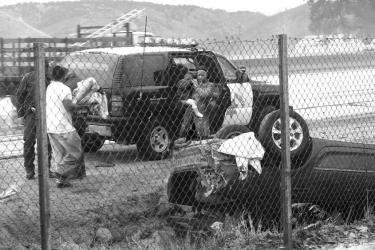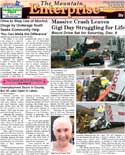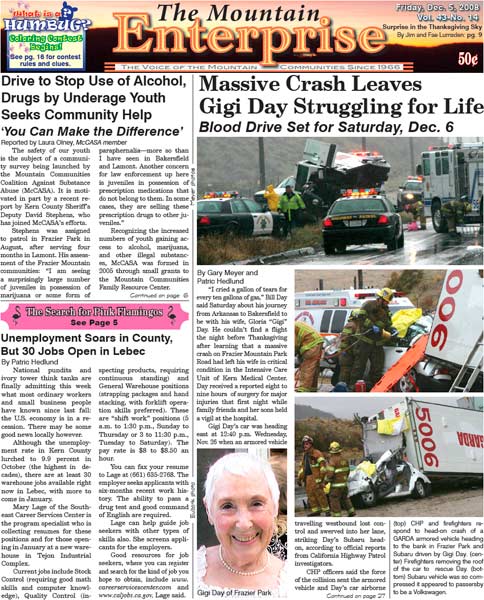
This family survived a crash on Wednesday, Nov. 26 at about 12:40 p.m. on the Interstate 5 in Lebec. A man, woman and small child walked away from this overturned vehicle. California Highway Patrol records were not yet available for this crash as we go to press, but (with the another account in this issue and the crash involving Gigi Day) we?ve documented three major accidents within the same two hours in our neighborhood the day before Thanksgiving. Please drive safely. ?Editor.
News To Use From The Mountain Enterprise
Storms and wild winter weather bring with them a list of hazards that are less threatening when you are prepared. Black ice, rock slides, obscured visibility, tule fogs, high winds, washouts and flash floods are all part of our winters. Rain, fog, snow and ice each requires different driving tactics.
This page has two parts: specific tactics for specific bad-weather driving conditions and a checklist to help you prepare in advance for winter safety. Keep a copy posted on the refrigerator door and keep another in your car for a quick reminder of driving tips when conditions turn rough.
Vehicle Checklist for Winter Driving
- Snow tires and four wheel (or all-wheel) drive vehicles are a good idea here.
- Check that headlights and taillights are in proper working condition.
- Check the antifreeze in the radiator.
- Are windshield wipers in good condition and the washer full of fluid?
- Are tires and chains in good condition?
- Is your defroster working?
- Are muffler and exhaust system in good condition, without leaks?
- Keep plenty of gasoline in tank—expect long waits during winter storms.
- Carry a small shovel.
If you are visiting backcountry roads and trails, the Forest Service suggests these precautions
√ Before you begin: Contact the Forest Service office nearest your destination for current conditions and check local weather reports (numbers below).
- Take a map of the area with you and know how to read it.
- Make sure you have tire chains and know how to install them.
- On Mt. Pinos, park only in vehicle turnouts or on the “downhill” side of the road. Allow enough room for traffic to pass safely in both directions.
- Midday snow melt followed by afternoon refreezing create dangerous ice on roads. Plan to arrive early and leave for home before 3 p.m. for safety.
- Bring warm jackets, hats, gloves, sturdy footwear, dry socks, emergency blankets and an extra set of dry clothes.
- Pack extra food and drinking water, along with essential medications.
- Leave your itinerary and expected time of return with a family member or friend.
- Bring a first aid kit, shovel and flashlight with new batteries. These are crucial if weather changes or if your vehicle (or that of someone you are trying to help) breaks down.
- If you become lost or injured, stay calm and get out of the wind if possible. Stay put! Searchers have a better chance of finding you if you remain near your planned route.
- Cell phones are helpful, but they do not work in many areas of our forests here.
Know Before You Go: always check ahead for road conditions
Caltrans Interstate 5 Information (800) 427-7623
Pine Mountain Club (661) 242-4017
Forest Service Roads (661) 245-3731
Mount Pinos Ranger District (661) 245-3731
Rain Driving Tips
- Slow down; even the speed limit may be too fast in rain. Leave four car lengths between your car and the one in front of you so there is time to brake.
- Be sure tires have plenty of tread and are properly inflated; many accidents have been caused in this area by inadequate tire tread.
- Wiper blades and defrosters need to be in working order.
- When slowing or stopping, gently apply the brakes to avoid skidding out of control.
- Drive with headlights on (California law requires headlights to be on at all times windshield wipers are in motion).
- Stay alert for signs of hydroplaning. Slow down.
- To prevent carbon monoxide poisoning or drowsiness, leave your window open slightly.
Fog Driving Tips
- Consider postponing your trip until the fog clears.
- Drive with headlights on. Low beams may help you see better through the fog and reduce the glare.
- Reduce your speed and avoid crossing traffic unless absolutely necessary.
- Listen for traffic you cannot see.
- Use wipers and defrosters for maximum vision.
- Don’t stop on a freeway or other heavily traveled road. Be patient, don’t pass lines of traffic.
- If your car stalls, move away from the vehicle.
Ice and Snow Driving Tips
- Adjust your speed to match conditions. Safe speeds on dry roads are deadly on ice. Observe speed limits.
- Driving interval is critical: Double the distance you’d allow on dry roods between you and the car ahead. That margin of safety may save your life.
- Stopping: Never apply brakes suddenly. Pump them gently to avoid locking the wheels. Use a lower gear if possible.
- Starting: Use smooth gentle starts to avoid spinning the tires. Clear all windows and exterior mirrors of snow and ice before starting out.
- Skidding: take your foot off the gas and off the brake. Turn the steering wheel into the direction of the skid, then back into the direction you wish to point the car.
This is part of the December 05, 2008 online edition of The Mountain Enterprise.
Have an opinion on this matter? We'd like to hear from you.


